
October
2017 |
 |
|
|


A Message from America's
World War I Centennial Commission
Last month we asked readers to respond to the request from the Centennial Commission to suggest inscriptions for the new national World War I Memorial in Washington, DC. Your response has been wonderful. I've sent two large packets of recommendations to the Commission and designers of the memorial and another will be heading out this week. Mr. Edwin Fountain, who is leading the Commission's effort to build the monument has asked that I share this message with you. MH
On behalf of the World War I Centennial Commission, I would like to thank the readers of the St. Mihiel Trip-Wire for their submissions of suggested quotations for inscription on the National World War I memorial in Washington. The suggestions we have received, while including a number of statements by national and military leaders, have been especially rich in eloquent testimonials from doughboys themselves. Inclusion of some of those submissions will honor the service of the troops on the ground and create a poignant counterpart to the nearby memorial to their commander, General Pershing. Thanks so much for the submissions received to date, and keep them coming!
Edwin Fountain, Commissioner and Vice-Chairman

|
2017
Centennial Conference:
The National Guard in World War I
Faneuil Hall
Boston, MA
19-20 October 2017
Flyer: HERE
Quarterly Meeting
Mid-Atlantic Chapter, League of World War I Aviation Historians
National Air and Space Museumís
Steven F. Udvar-Hazy Center, Dulles Airport
Sinking the Ostfriesland, September 1917, Impact of Aerial Bombing on the War
28 October 2017
Details: HERE
2017 SYMPOSIUM
1917 America Joins the Fight
National WWI Museum & Memorial
Kansas City, MO
3-4 November 2017
Details HERE
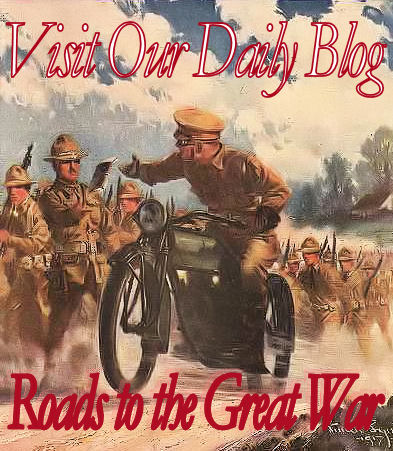
Click on the Image to Visit Our Daily Blog.
|
|
Poster of the Month
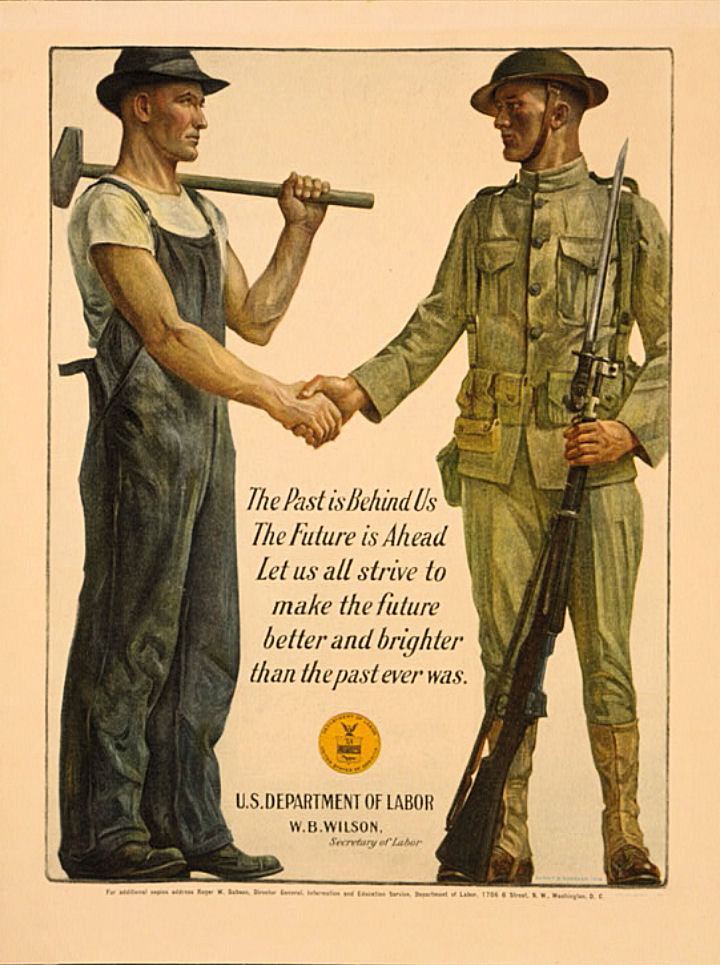
U.S. Department of Labor Poster
Artist: Gerrit A. Beneker, 1918 (LOC Collection)

1914-1918-Online: International Encyclopedia of the First World War – American Topics
Last month we introduced readers to 1914-1918-online–International Encyclopedia of the First World War and presented a sampling of their excellent articles that cover the war in general. This month, we present a more focused selection covering the American experience in the war.
 Nancy Gentile Ford: Civilian and Military Power in the USA
Nancy Gentile Ford: Civilian and Military Power in the USA
 Mark E. Grotelueschen: American Warfare 1917-1918
Mark E. Grotelueschen: American Warfare 1917-1918
 Paul G. Halpern: Naval Warfare 1917-1918
Paul G. Halpern: Naval Warfare 1917-1918
 Jennifer D. Keene: United States of America (Overview)
Jennifer D. Keene: United States of America (Overview)
 Mark Levitch: The Spirit of Ď76 (Film)
Mark Levitch: The Spirit of Ď76 (Film)
 Mitchell Yockelson: American Prewar Military Planning
Mitchell Yockelson: American Prewar Military Planning

Can You Name This WWI Veteran?
Win a Free Issue of OVER THE TOP!
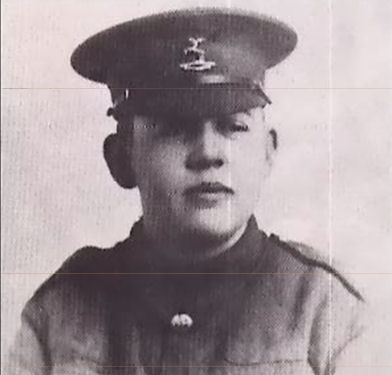
Hint: Being gassed gave this Buckinghamshire Regiment Tommy a unique and unforgettable voice.
If you can name this World War I veteran, we will send you a free issue of our monthly subscription magazine, OVER THE TOP. Email your answers HERE.

Experiencing Gas
I went thru the 'tear gas' and "chlorine gas' chambers one afternoon. A couple of Tommies took me into the shanty which was filled with tear gas. I stood it for about 30 seconds until the water literally flowed out of my eyes and the smart was terrible. This gas is used in shells and blinds one temporarily; permanently if strong enough. Gas masks are tested in this chamber. The wearer is sent thru and his eyes examined after emerging. If there are no tears in his eyes, the mask is alright. The chlorine gas chamber was a long passageway about 60 ft long. Clouds of chlorine vapor were spouting from a pipe at one end and drifting towards us. We held our breath and ran for the other end. When I came out I had enough gas in my nose and lungs to kill a cat. The stuff grips one and causes stomach sickness and choking.
Pvt. Hazen S. Helmrich
Base Hospital 17
|

|

U.S. Centennial Organizations & Resources
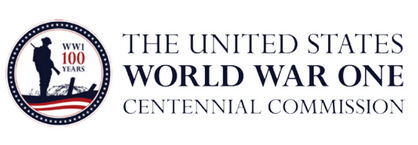
worldwar-1centennial.org/

theworldwar.org/
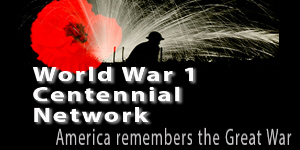
www.ww1-centennial.org/

www.firstdivisionmuseum.org/

www.abmc.gov/
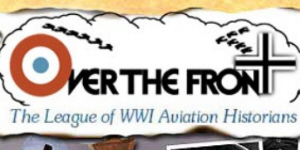
www.overthefront.com/
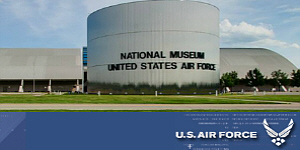
www.nationalmuseum.af.mil/
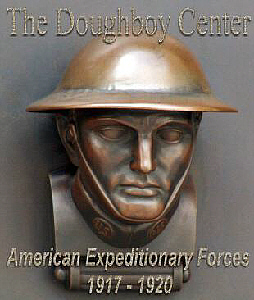
www.worldwar1.com/dbc/
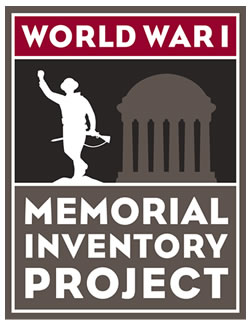
facebook.com/wwiinventory

wisconsinhistory.org/

www.uswarmemorials.org/

www.macarthurmemorial.org/

www.saving-hallowed-ground.org/
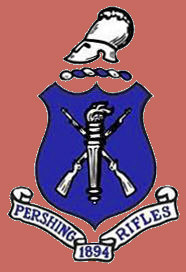
www.theprgroup.org/

pamilmuseum.org/
Support Worldwar1.com's Centennial Effort
Shop at Amazon.com
|
The Centennial Ticker
No one else seems to be commemorating the incredible feat of transporting a two-million-man expeditionary force across the Atlantic Ocean through U-boat infested waters, so I thought we should do so here at the Trip-Wire. This is our main feature on the "Centennial Ticker" this month.
Commemorating the Deployment "Over There"
We'll be over, we're coming over,
And we won't come back till it's over
Over there.
After the April declaration of war, the American deployments to Europe were minimal, but for October 1917 the numbers jumped to over 30,000 for that single month. That level would be maintained over the winter months and would then begin growing exponentially through the summer, peaking at 10,000 men per day in July 1918. During the 19 months of U.S. involvement over 7.5 million tons of supplies also accompanied the troops.
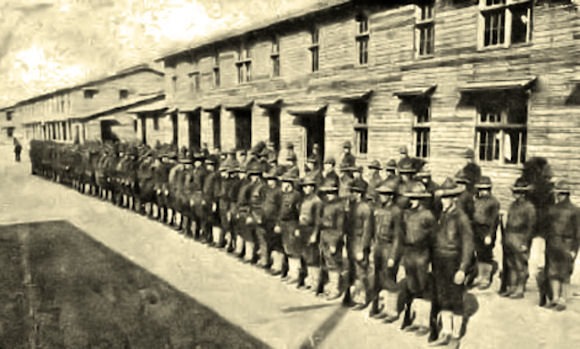
Camp Dix: Ready for France
Four Canadian and six American embarkation ports were used for transporting the AEF. Nearly 83 percent of the Doughboys (1,656,000), however, departed from New York area ports, including Hoboken, NJ.
At four o'clock we started down the main road leading to the railroad station. As we passed the other barracks, heads appeared at the windows to wave farewell to some comrade or to wish the men good luck and "God's Speed." The hour being early, there were no people at the station with the exception of the regular force and a former member of our company. He had been transferred two days previous to another organization that was to remain in the United States. There were tears in his eyes as he wished us good luck.
News of our coming had evidently preceded us for whistles and sirens blew and along the way workmen waved to us from various buildings. At Jersey City a crowd of people had gathered. We passed through the crowd in a lane made by soldiers with fixed bayonets. A ferry was waiting for us that took us to the "Bush Terminal" at Brooklyn. A few minutes wait on the pier and the battalion filed up the gangplank, receiving a final checking as they did so, to board HMS Kia Ora.
Albert Haas, 78th Division
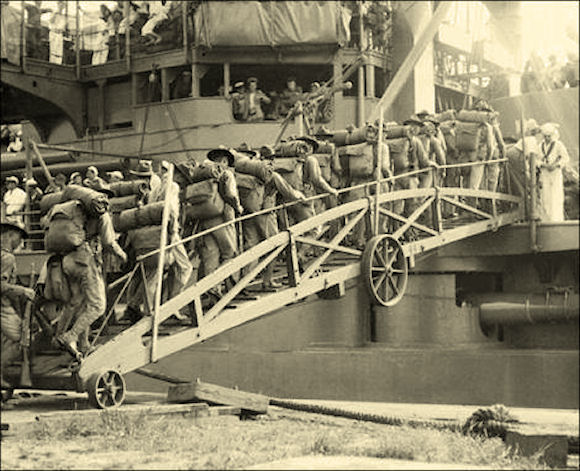
Doughboys Loading onto a Navy Warship
Fully half of the AEF was transported by British controlled vessels. The American share constituted another 45 percent, although a good share of this work was accomplished by German vessels seized by the government. Allies, Italy and France, provided the remaining 2-3 percent of the shipping needs.
The most popular debarkation sites were Brest (791,000) and Liverpool (844,000). A surprising detail is that almost 50 percent of the men initially landed in England rather than France, and then traveled across Britain and the Channel to the continent.
Each man was given a cloth tag which was to serve as his meal ticket besides showing the number of his hatch, letter of his deck, number of his bunk and [life] raft or boat number. This tag was to be worn at all times and to be punched at each meal.
Al Burns, 113th Engineers
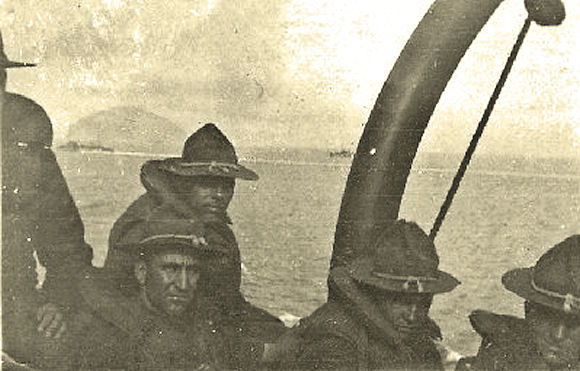
In Transit to France – Lifeboat Drill
The trip Over There was both exciting and boring for the soldiers. Lifeboat drills and the sounding of U-boat alarms livened things up. Troop losses in transit were low, but not non-existent as some sources claim. Most notably
the sinking of SS Tuscania and HMS Otranto led to serious American fatalities.
The torpedo had struck us [aboard the SS Tuscania] squarely amidships on the starboard side. A great hole was torn in the hull. . . These ten or fifteen minutes elapsing from the moment we were struck were filled with action. With all indications of a speedy sinking staring us in the face, we worked feverishly to lower the lifeboats and cut away the rafts. . .
Henry J. Askew, 20th Engineers
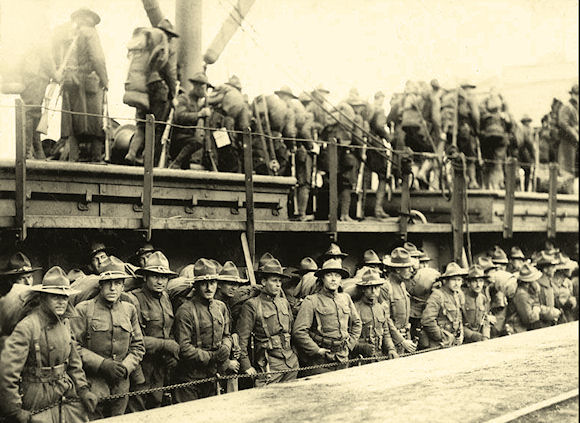
4th Infantry Arriving in Brest
All in all, and despite the somewhat helter skelter rapid mobilization of the nation, the transport of the AEF to Europe was a tremendous success, given that the German Admiralty had advised that not a single American soldier would ever set foot in France. By Armistice Day, 2,057,675 members of the military had been transported to Europe.
A Frenchman raised his cap and waved to the soldiers leaning over the rail and cried, "Vive l'Amerique? Vive les Americaines!" A Doughboy on the deck called back through his hands, "Vive yourself, you damned frog!"
Charles M. DuPuy, 79th Division
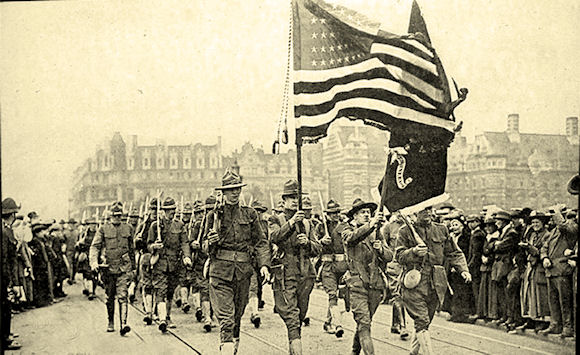
American Troops Parade in Liverpool
Had the war continued into 1919, two million more Doughboys were to be sent Over There during the first half of the year. Fortunately, they were not to be needed.
Dear Wife,
Will write you a few lines to let you know that I am all OK and doing fine. . . The place we are in now is sure fine, and the people treat the U.S. boys like kings and they sure cheer us when we go marching by.
Wayne Wills, 28th Division
|

October 1917
Italy Loses an Entire Army at Caporetto
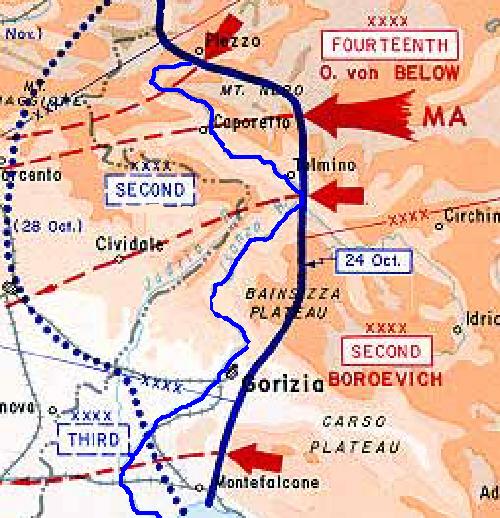
Initial Attack & Advance by Central Powers at Caporetto
The Battle of Caporetto began at 2:00 a.m. on 24 October 1917 with an artillery bombardment. Italian trenches were destroyed by the Austro-German Army's brief, but very intense, artillery barrage, and the survivors of the artillery attack were quickly surrounded and overrun by the fast-moving enemy columns. The Austro-German infantry assault was greatly helped by the dense fog that provided them with cover until they were almost on top of the Italian trenches. Poison gas was used widely and proved especially lethal in the Plezzo basin, where possibly the most successful chemical warfare attack in history took place. The XIV Austro-German Army took only two days to capture all their immediate objectives around the Isonzo River. The subsequent exploitation, pushing the Italian forces back to the Piave River, lasted about a month. The key to the success of the Central Powers at Caporetto was a double breakthrough that shattered the entire Italian defensive deployment the first morning of the battle.
Tolmino: Southern Breakthrough Point
Because of the bridgehead at Tolmino (see map), German forces deployed there could attack on both sides of the Isonzo River. Further, a successful breakthrough at this point would place them behind the first and second Italian lines on the right (east) side of the river. This decisive attack was launched from the Tolmino bridgehead against the Italian XXVII Corps. Italian defenses were far stronger at Tolmino than at Plezzo, but still inadequate. Few of the XXVII Corps's artillery batteries managed to open fire before being overrun. Italian command and control were successfully targeted by Austro-German artillery and Italian Second Army's headquarters was left unable to effectively issue orders or receive news from the front. Throughout the battle, the Italian artillery performed miserably, either because the batteries were overrun or because they never received orders to open fire. The Italian infantry was left with little or no artillery support throughout the battle. Tens of thousands of Italian troops deployed on the mountains on the east side of the Isonzo were captured en masse, many never firing their weapons.
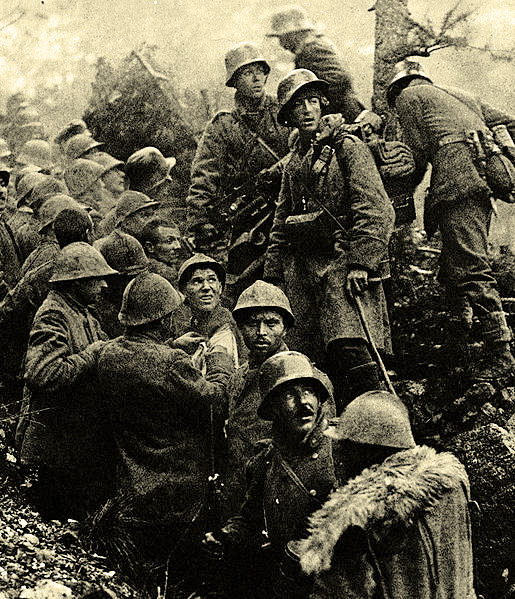
Italian Soldiers with German Captors Near Caporetto, October 1917
Plezzo: The Northern Breakthrough Point
The assault through the Plezzo basin was preceded by a massive gas attack on the night of 23-24 October. Italian gas masks were ineffective against the mix of phosgene and diphenylchlorasine used by the Germans. The entire Italian 87th regiment deployed in defense of the Plezzo basin was killed in the attack. At dawn, the I Austro-Hungarian Corps attacked down the Isonzo valley from Plezzo, encountering only sporadic and poorly coordinated resistance until they reached the Saga Narrows.
Near Knock-Out
At Caporetto, the Italian Army suffered one of the most stunning defeats of the entire First World War. Italian casualties totaled 40,000 dead and wounded, over 280,000 prisoners and 3,150 artillery pieces captured. The Italian Army was reduced in size by one half, from 65 infantry divisions to 33 and the Italian province of Friuli was abandoned to the enemy along with much of the Veneto Province. The entire Italian Second Army was wiped off the board. Today, 100 years after the event, Italians still say "It was a Caporetto" to mean "It was a complete disaster."
|
|

Our 2018 Centennial Battlefield Tours
2018
Kaiser's Offensives &
the British Army's 100 Days
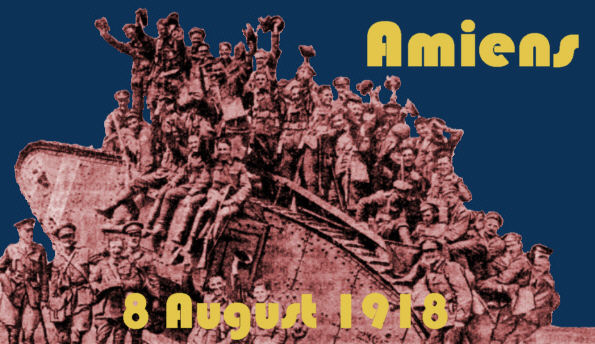
6 – 14 May 2018: Study of Germany's Last Effort to Win the War and the British Victory Offensive.
Includes: German advances in the Somme, Flanders, and the Marne Sectors, the Black Day of the German Army, the St. Quentin Canal, and the pursuit to Mons.
Reduced Price — $3,450 (dbl occupancy, sgl supp avail)
The full brochure covering the trip and registration details can now be downloaded
HERE
AEF: Pershing's Doughboys Centennial
Now Fully Booked – Waiting List Only
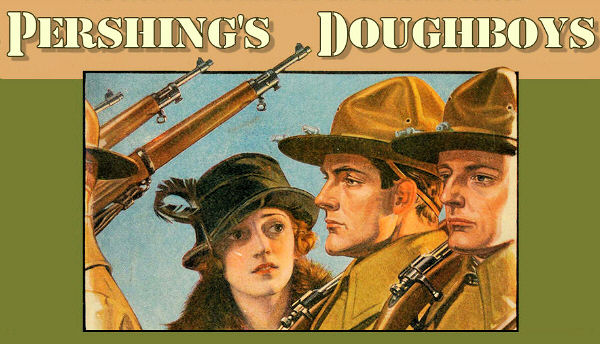
7 – 17 August 2018: Comprehensive Study of the American Expeditionary Force
Includes: All major battles, memorials, cemeteries, and service sites of your family members.
Price — $3,750 (dbl occupancy, sgl supp avail)
The full brochure covering the trip and registration details can now be downloaded
HERE
|
|
|
|
Thanks to each and every one of you who has contributed material for this issue. Quotes for the "Over There" article were found at American Voices of World War I by Martin Marix Evans and Doughboy War by James Hallas. Until our next issue, your editor, Mike Hanlon. |
|
 (Or send it to a friend)
(Or send it to a friend)
|
Design by Shannon Niel
Content © Michael E. Hanlon
|
|


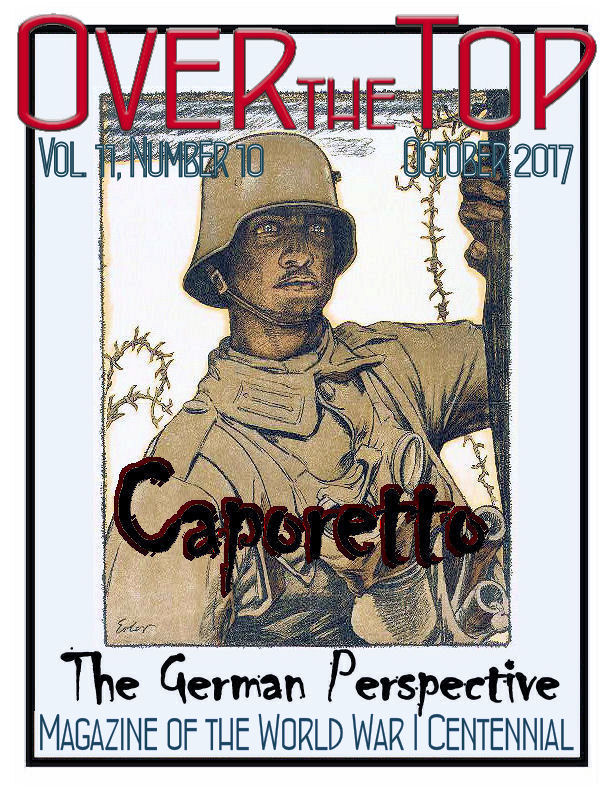




![]() Nancy Gentile Ford: Civilian and Military Power in the USA
Nancy Gentile Ford: Civilian and Military Power in the USA
![]() Mark E. Grotelueschen: American Warfare 1917-1918
Mark E. Grotelueschen: American Warfare 1917-1918
![]() Paul G. Halpern: Naval Warfare 1917-1918
Paul G. Halpern: Naval Warfare 1917-1918
![]() Jennifer D. Keene: United States of America (Overview)
Jennifer D. Keene: United States of America (Overview)
![]() Mark Levitch: The Spirit of Ď76 (Film)
Mark Levitch: The Spirit of Ď76 (Film)
![]() Mitchell Yockelson: American Prewar Military Planning
Mitchell Yockelson: American Prewar Military Planning















